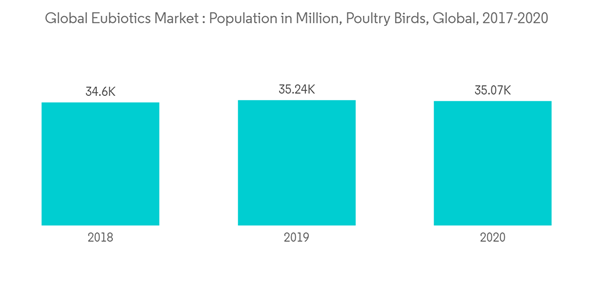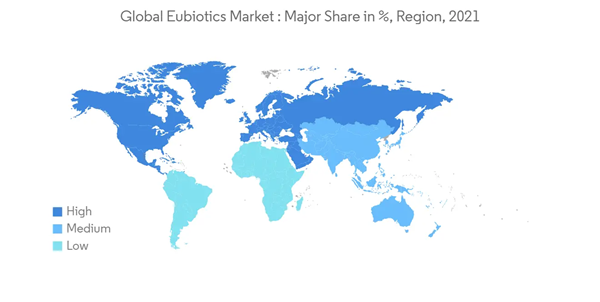The COVID-19 pandemic moderately impacted the eubiotics industry. The impact was mixed on the industry as the companies suffered economic losses due to social restrictions in the major markets. However, the pandemic resulted in increased awareness about the adverse effects of antibiotics on animals, influencing the market's growth positively.
The eubiotics market is emerging as antibiotic alternatives or antimicrobials byproducts in the animal feed industry, intended to boost livestock's immunity and gut health while acting as livestock nutrition. Manufacturers are focusing on maintaining a balance in the ingredients used in the production of eubiotics to optimize nutrient absorption. In addition, the imposition of bans on antibiotics in North America and Europe, rising prices of natural feed grades, and the use of feed enzymes for cost reduction of feed grades contribute to the market's growth.
Probiotics led the market and account for a major share of the global revenue in 2021. Their demand is driven by their growing utilization, as probiotics produce specific antibacterial substances, resulting in increased immunity. For instance, probiotics, including Enterococcus Faecium, are utilized in several end-use applications, including immunity development and gut health maintenance. In addition, rising awareness concerning the usage of probiotics and strategic initiatives adopted by key manufacturers to generalize the usage of probiotics is anticipated to fuel the product's demand over the forecast period.
Poultry feed emerged as the largest end-use segment and accounted for more than 20% of the global revenue in 2021. Growing demand for poultry meat and concerns over meat quality are driving the segment's growth. There has been a mounting demand for poultry meat and products such as eggs worldwide, thereby compelling poultry industry players to implement competent methods to upsurge yield.
Eubiotics Market Trends
Industrialization of the Livestock Industry
The livestock sector saw significant changes in the last decade. The surging demand was fulfilled by commercial livestock production and their associated value chains. In many markets, such as China, Japan, and India, animal husbandry transformed into a highly diversified activity, emphasizing the scientific management of farm animals, improving productivity, and saving costs. According to the World Bank, the adoption of industrialized meat production is growing six times faster than that of traditional meat production. With an increase in the mass production of meat, the trend of landless meat production facilities is catching up. Large-scale meat production can lead to high water consumption with soil and water contamination. An estimated 60-90% of nitrogen and phosphorous consumed by animals act as a pollutant in the form of animal waste. Enhancing the digestibility of the feed is one of the most important functions performed by eubiotics, which help absorb these nutrients into animal tissues, thereby reducing animal waste. By helping improve the body mass of meat animals and nominally reducing the environmental impact of livestock rearing, the usage of eubiotics is anticipated to increase due to the increased industrialization of livestock rearing.Increasing Eubiotics Consumption in Europe
Europe emerged as the largest regional segment and accounted for more than 40% of the global revenue in 2020. Efforts taken by livestock producers to comply with the prevalent regulations and ban on the usage of antibiotics are resulting in high product demand. The growth of the market for eubiotics in the region is characterized by the presence of strict laws and regulations discouraging the usage of antibiotics, which is expected to benefit the market. Strong awareness regarding the usage of eubiotics and their benefits, the presence of market players, and strong demand from countries such as Germany, the United Kingdom, France, and Spain are driving the overall regional demand.Eubiotics Industry Overview
The eubiotics market is fragmented and competitive and is characterized by the presence of several small, medium, and large industry players operating globally. Leading companies are focused on acquiring feed mills and small manufacturers are expanding their businesses in local and foreign markets. Some of the players have been expanding their geographical presence by acquiring or merging with the manufacturers in the foreign markets. The key players in the market are implementing various strategies, including the expansion of product portfolio, mergers and acquisitions, and partnerships, to increase their business share and tap the growth opportunities.Additional Benefits:
- The market estimate (ME) sheet in Excel format
- 3 months of analyst support
This product will be delivered within 2 business days.
Table of Contents
Companies Mentioned (Partial List)
A selection of companies mentioned in this report includes, but is not limited to:
- BASF SE
- Cargill Incorporated
- Novozymes
- E. I. du Pont de Nemours and Company
- Kemin Industries Inc.
- Lallemand Inc.
- Koninklijke DSM NV
- Chr. Hansen Holding AS
- Addcon
- Novus International Inc.










